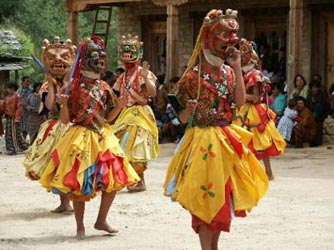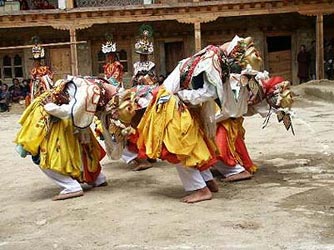 |
|
Festivals
in Bhutan
|
 |
|
TSHECHU (RELIGIOUS FESTIVAL)
|
 |
| Tshechu
Mask Dance
The
Tshechu is a festival in honour of Padmasambhava-"one who was born from
a lotus flower", popularly known under the name of "Guru Rimpoche", the
Precious Teacher. This Indian saint contributed enormously to the diffusion
of Tantric Buddhism in the Himalayan regions of Tibet, Nepal, Bhutan etc.
around 800A.D. He is the fonder of Nyingmapa, the "old school" of Lamaism,
which still has numerous followers. |
|
The
biography of Guru Rimpoche is highlighted by 12 episodes on the model of
Buddha Shakyamuni's life.
Each
episode is commemorated around the year on the 10th day of the month by
"The Tshechu" which has become the name of a very popular festival.
The
dates and the duration of the festival vary from one district to another
but they always take place on or around the 10th day of the month according
to the Bhutanese calendar.
During
Tshechus, the dances are performed by monks as well as by laymen. The Tshechu
is a religious festival and by attending it, it is believed one gains merits.
It is also a yearly social gathering where the people come together to
rejoice dressed in all their finery.
|
THIMPHU
DRUBCHHEN AND TSHECHU (RELIGIOUS FESTIVAL)
|
The
eleven-day annual Lhamoi Dubchhen, a rite performed to appease the protecting
deity Pelden Lhamo (Mahakali), will be held in September. The clergy is
performing a three-day rite for the Thimphu Domchoe while the Lham Tsomo
dance, a highlight of the Thimphu Domchoe festival, will be performed
in the courtyard in the Tashichhodzong. The Dubchhen was instituted sometime
between 1705 and 1709 by Kuenga Gyaltshen, the first reincarnation of Jampel
Dorji, the son of Zhabdrung Ngawang Namgyal.
The
annual Thimphu Tshechu, introduced in 1687 during the reign of the fourth
Desi, Tenzin Rabgye, will take place over four days end of September.
In other religious events, the annual Phurpai Dubchhen (Vajra tradition)
ceremony at the National Memorial Chorten will conclude also end of September
with the Nguedup Langwa (receiving of spiritual wisdom/power) in the morning
and Jinseg (a sacred fire offering) later in the day.
top
|
SIGNIFICANCE
OF THE MASK DANCES
|
 |
| Durdag Chham - Dance of the Cremation Ground
Dance
and music play a very important part in the cultural life of people. Each
village and community has a rich tradition of dance, which marks the passing
seasons, communal occasions and shared experiences. Just like the building
of the dzongs and the setting up of the Chhoesi System, the dances have
had a similar part to play in helping to unite the people. Through
these dances, the ordinary people come to know their place in the history
of the country. Chhams "Religious Mask Dances" are usually performed during
Tshechus. |
|
The
Chhams were composed mainly to convey religious messages to the people.
Some
were composed by Guru Rimpoche while others were created by Tertoen Pema
Lingpa, Zhabdrung Rimpoche and other great saints. During the mask dances,
the deities of the tantric teachings are invoked and through their power
and blessings, misfortunes are removed. All evil spirits and demons which
are preventing the spread of Chhoe "The Doctrine" are suppressed so that
the doctrine of Lord Buddha flourish and bring joy and happiness to all
sentient beings.
|





